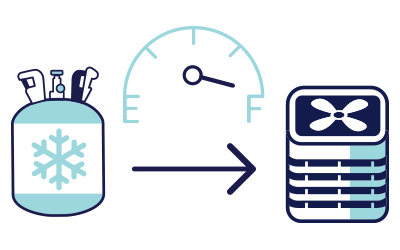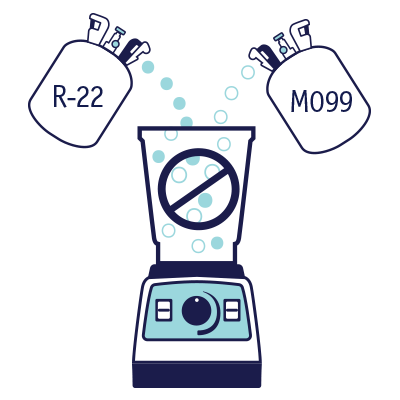Air Conditioner
Repair Options
Your air conditioner repair options:
recharge, retrofit or replace
Was your air conditioner manufactured before 2013? If so, you have a very important question to ask yourself:
Should I recharge my system with R-22, get an air conditioning retrofit and use an alternative refrigerant or replace it with a newer air conditioning unit?
How you answer this question can affect your budget and comfort for years to come. But there’s no universal answer to this question. You and your home are unique, which is why you should understand the pros and cons of each option. We want to give you the best information to help you make the most informed and educated decision for your specific situation.

Pre-2013
A/C units may require alternative refrigerants or can be replaced.

Recharging
is becoming increasingly more expensive and time consuming.
Recharging or topping off your
air conditioner
Someday, your air conditioner will run low on refrigerant, which is what makes the air cold. When your refrigerant runs low, the process of adding more is called recharging (or topping off). All that means is that a professional refills your air conditioner with chemical refrigerant.
While getting a home air conditioning recharge is acceptable during a repair or maintenance visit, it’s also becoming more expensive and inconvenient for older air conditioning units for several reasons:
- As of January 1, 2020, it's illegal to manufacture or import R-22 in the US. This makes it difficult for even HVAC professionals to track down R-22 through suppliers.
- If a technician does work on R-22 systems, it can also take some time for them to acquire the refrigerant itself. That means you’ll have to wait for your air conditioner to be functional again.
- Other technicians refuse to carry R-22 refrigerant anymore due to the detrimental environmental impact it has on the Earth’s ozone.
In short, recharging with R-22 is likely to get even more expensive and inconvenient than it already is. The good news is that you still have two viable options that are longer-term fixes and more environmentally friendly: retrofit or replace.
The benefits of getting an air conditioning retrofit
Between replacing or getting an air conditioning retrofit, retrofitting is usually the less expensive option. If your existing air conditioner is 15 years old or younger, it likely still has years of life left. That’s why retrofits have become so popular. In many cases, your best option is to have your older air conditioner retrofitted to work with one of the many alternative refrigerants available today.
Most homeowners are unfamiliar with how having their A/C unit retrofitted to use a new refrigerant works. If an HVAC technician recommends an air conditioning retrofit, they’re making that recommendation with the following benefits in mind:
- Retrofitting helps your air conditioner get repaired faster. R-22 refrigerant is expensive and hard to source, while alternative refrigerants are widely available. Using alternative refrigerants will help get your home cooler, faster.
- HVAC technicians don't always carry R-22. It’s becoming more difficult to acquire as the government continues to phase out its production, and most technicians won’t have easy access to a supply.
- Retrofitting “future-proofs” your home’s air conditioner. This makes it more serviceable in the future. Alternative refrigerants can make future air conditioner repairs easier, faster and better for the environment.
- R-22 is bad for the environment. Due to its chemical structure, R-22 breaks down the Earth’s life-protecting ozone layer. Alternative refrigerants do not deplete the Earth’s ozone.
Retrofitting makes your A/C more serviceable in the future
R-22 is obsolete, and moving to an alternative refrigerant the next time you need A/C repairs can make future repairs easier, faster, less expensive and better for the environment.
Do I need to retrofit my air conditioner or can I mix refrigerants?
Many people mistakenly think that they can avoid retrofitting by simply mixing refrigerants. Please know that knowingly mixing refrigerants is illegal. The EPA prohibits refrigerant mixing because it’s impossible to recycle mixed refrigerants properly. You can’t just release refrigerant chemicals into the air. A professional must remove it from the system and recycle it properly.
Besides, when moving from R-22 to an alternative refrigerant, the process is a bit more complex than simply adding the new refrigerant into the existing system. Here’s why:
- Different refrigerants function under varying pressures. Mixing them can cause inefficiencies at best and serious A/C damage at worst.
- Different refrigerants require different oils (i.e., lubricants) to keep the compressor lubricated and functioning efficiently. For example, R-22 A/Cs use mineral oil, but R-410A systems require synthetic lubricants. Using the correct oil means your compressor will last longer without burning out.
Due to these differences in functionality, an A/C’s existing R-22 refrigerant must be drained from the system properly. Additionally, certain seals and other components must be replaced.
Thankfully, the retrofitting process is straightforward and quick to complete. If an HVAC professional suggests retrofitting your A/C for a new refrigerant, it should take a matter of days, not weeks or months.

Knowingly mixing refrigerants is illegal
The EPA prohibits refrigerant mixing because mixed refrigerants cannot be recycled properly. Refrigerant chemicals cannot simply be released into the air. They must be removed from the system and recycled appropriately.
How an older air conditioner gets retrofitted for alternative refrigerants
The retrofitting process depends on the type of alternative refrigerant your HVAC professional will use. For example, some alternative refrigerants, like MO99, will already be compatible with the oil that your current A/C’s compressor uses, while others won’t be. Retrofitting an R-22 system also requires replacement of certain parts in your A/C, such as the filter drier and critical elastomeric seals/gaskets.
Different refrigerants also have different pressures, and they can flow through the system in different ways. All of these differences require specific tools and techniques.
However, retrofitting an older A/C to accept an alternative refrigerant like MO99 ensures that technicians can more easily fix your A/C. There are many different types of alternative refrigerants available, but they all achieve the same goal: getting your A/C to blow cold air.
Regardless of the alternative refrigerant you end up using, your A/C should be functional and cooling your home effectively after your HVAC technician completes the process. Most importantly, retrofitting your A/C makes future refrigerant-based repairs less expensive and more convenient for you.
Next, we’ll look at a commonly used refrigerant, MO99. MO99 often requires the least retrofitting because it uses mineral oil, like R-22. (Reminder: It is illegal to knowingly mix refrigerants. Just because MO99 and R-22 use the same oils does not mean you can mix them.)

Future Proofing
Retrofitting your A/C unit will make future repairs easier and faster.
Retrofitting an R-22 system with MO99 alternative refrigerant
When an HVAC technician retrofits your A/C for an alternative refrigerant, such as MO99, here’s what the process typically looks like.
Establish baseline performance
First, the HVAC technician will check the existing R-22 refrigerant’s performance.
Remove R-22
Next, the technician will remove the R-22 refrigerant from the system. This process is also called recapturing. During recapturing, the technician puts the refrigerant into a recovery cylinder. This prevents it from getting into the air, where it can cause damage to the Earth’s ozone. The technician will then weigh the refrigerant they removed.
Replace components
All retrofits require some equipment replacement. In this instance, the technician will replace the filter drier and critical elastomeric seals/gaskets. The technician will then install new equipment compatible with MO99.
Evacuate the system and check for leaks
The technician will then evacuate your A/C’s system using a special vacuum pump. This process removes moisture and any other contaminants from the system.
Your A/C’s compressor needs oil to function. The technician will add this oil during this step if necessary. When switching to MO99, you should not need a wholesale oil change.
Charging with MO99
Charging simply means adding the new refrigerant to your A/C system.
Starting and monitoring the system, and adjusting the TXV
This is the test run. The technician will fire up the A/C to ensure that everything is working properly. The thermostatic expansion valve (TXV) is a critical piece of equipment that regulates the rate at which refrigerant flows into the A/C’s evaporator coils. The technician will adjust it as needed.
Monitor the compressor's oil levels
Your compressor needs oil to operate smoothly and efficiently. The HVAC technician will double-check that the oil levels are correct. The technician will add more oil if necessary.
Label the system
Every A/C unit has a label that states the type of refrigerant and oil it uses. After retrofitting, the technician will change your unit’s labels to reflect that information.
Replacing an old air conditioner
There’s a final option on your quest for a cool house: replacing your old A/C with a newer model.
Should you replace your A/C?
This is a question that depends on your specific situation. But keep in mind that retrofitting an older system to work with alternative refrigerants extends the longevity of the A/C.
Retrofitting also reduces your environmental impact. Manufacturing an entirely new A/C system for replacement is far more environmentally taxing than getting as much use as possible out of your existing system. Retrofitting also gets your A/C system running more quickly than replacing it.
If you do opt for a replacement, the best time to replace your A/C is during fall or spring. HVAC companies aren’t as busy when the weather is more temperate, which means you can get installation scheduled faster. You’re also likely to get a better deal on a new A/C system during these times, since temperatures are comfortable and homeowners aren’t requesting service as often.
Newer models have the added bonus of using alternative refrigerants, too.

Is having a new air conditioner important to you?
For some homeowners, having modern systems in their home is important. There’s nothing wrong with that! If you want to replace your A/C with an upgraded model and you have the funds to do so, the best time to replace your A/C is during fall or spring.
Frequently asked questions about air conditioners and refrigerants
What is a Refrigerant?
Refrigerants, also called coolants, are the chemical compounds that work with your air conditioning system to provide your home with cool air. R-22 is the most common type of refrigerant found in air conditioners that were manufactured before 2010.
There are different types of refrigerants, and the use of these compounds is regulated by the Environmental Protection Agency. That’s because their usage has an impact on the environment, and our understanding of that impact continues to develop and evolve over time.
WHAT IS R-22?
R-22 is a hydrochlorofluorocarbons (HCFC) and a type of refrigerant gas that has been used in air conditioning systems for many years.
The EPA’s Clean Air Act of 2010 mandated the phase-out of R-22 production, because researchers discovered that it depleted the ozone. The government mandated a 90% reduction in R-22 production by 2015, and a 99.5% reduction by 2020.
HOW CAN I TELL WHEN MY AIR CONDITIONER WAS MANUFACTURED?
Manufacturers always include the date of manufacture in the air conditioning unit’s serial number, though they can be displayed differently.
The manufacture date, sometimes written as MFG date, usually appears on the nameplate of your A/C unit, near your serial and model number.
If you can’t find the manufacture date, but you do see the serial number and model number, simply enter the serial number, model number, and the brand name of your A/C into any search engine. It should bring the manufacture date up for you.
WHAT ARE ALTERNATIVE REFRIGERANTS?
Since HCFCs like R-22 were found to be environmentally damaging, it was determined that there needed to be another option. Alternative refrigerants are classified as hydrofluorocarbons (HFCs) and they don’t contain any ozone-depleting chlorine. Aside from being better for the environment, they’re more affordable than R-22, work efficiently and increase the serviceability of your A/C unit.
If your air conditioner uses R-22 and develops a leak or needs another repair, your HVAC technician may recommend that your existing A/C unit be retrofitted to accept an alternative refrigerant.
To learn more about the benefits of alternative refrigerants, click here.
CAN’T I JUST USE AN ALTERNATIVE REFRIGERANT IN MY OLDER AIR CONDITIONING SYSTEM?
If your air conditioner uses R-22 refrigerant, you can’t just top off with an alternative refrigerant. Your system would need to be retrofitted in order to allow the use of alternative refrigerants.
WHAT DOES IT MEAN TO “TOP OFF,” “RECHARGE” OR PERFORM A “GAS AND GO” ON AN AIR CONDITIONING SYSTEM?
When talking about adding more refrigerant to an air conditioning unit, technicians refer to the process as “topping off” or “recharging”.
Essentially, the chemical refrigerant inside of the unit is being refilled. When you hear the term “charging” it’s also a reference to adding refrigerant into the air conditioning system.
CAN I TOP OFF MY AIR CONDITIONER BY MYSELF?
No, you cannot top off your air conditioner’s refrigerant on your own. Federal law regulates the use and installation of refrigerants and special licensure and/or certifications are required for the professionals who work with these chemicals.
HOW CAN I TELL WHEN MY AIR CONDITIONER NEEDS MORE REFRIGERANT?
When your air conditioner needs to be topped off or recharged with more refrigerant, one of the first signs is warm or room temperature air.
However, there could be any number of reasons for a malfunctioning air conditioner. If you have a Home Warranty Service Agreement from 2-10 HBW, you can place a request for service and 2-10 HBW will dispatch a service contractor to your home. If you do not have a Home Warranty Service Agreement, you should call an HVAC technician to assess your system’s functionality.
WHAT SHOULD I DO IF MY AIR CONDITIONER BREAKS DOWN?
If you think you might have a problem with your air conditioner and you have a Home Warranty Service Agreement from 2-10 HBW, you can place a service request and 2-10 HBW will dispatch a service contractor to your home. If you do not have a Home Warranty Service Agreement, you can call an HVAC technician to assess your system’s functionality.
IS IT ILLEGAL TO BUY AN AIR CONDITIONER THAT USES R-22?
This is a problem you’re unlikely to encounter, since the manufacture and installation of new equipment using R-22 is now illegal.
Remember that you can still continue to service and maintain your existing air conditioner, even if it uses R-22. You just can’t install a new air conditioner that uses R-22.
HOW MUCH DOES IT COST TO USE AN ALTERNATIVE REFRIGERANT?
The costs of retrofitting an existing air conditioner to use alternative refrigerants will vary depending on the type of retrofitting that’s needed.
WHY CAN’T I JUST HAVE LEAKS IN MY A/C REPAIRED?
Yes. There are products in the market that can do an immediate and effective job of repairing and sealing refrigerant leaks even if the technician cannot find the leak’s location.
WHY WOULD MY AIR CONDITIONER NEED ALTERNATIVE REFRIGERANT?
Air conditioners can develop leaks over the course of normal use, which is one of the primary reasons your refrigerant would need to be topped off.
If your air conditioner was manufactured before 2013, it likely uses R-22 refrigerant. Due to EPA regulations this gas is good as gold — it’s expensive and hard to find.
WHAT IF MY R-22 IS ONLY SLIGHTLY LOW? WILL TOPPING OFF BE CHEAPER OR EASIER?
Topping off an A/C system with a known leak is illegal, but once the leak has been diagnosed and addressed by an HVAC technician, it can be a viable practice. Topping off with R-22 may be more economical in the short term. But, in the long run, R-22 is becoming more difficult to find, and that’s if you can find a technician who will even work with R-22 (many will simply refer you to someone else). Further, the technician can guesstimate how many pounds you’ll need, but you won’t know the final count until the refrigerant is being replaced.
WHAT DOES THE RETROFITTING PROCESS LOOK LIKE?
The retrofitting process will look different based on the type of alternative refrigerant being used. Some retrofits are easy and straightforward, with minimal or no equipment replacements needed.
Other retrofits are more complex and require additional components. For more information on how an air conditioner gets retrofitted, review How An Air Older Air Conditioner Gets Retrofitted For Alternative Refrigerants.
DO ALTERNATIVE REFRIGERANTS DEPLETE THE OZONE LAYER?
No, alternative refrigerants do not deplete the ozone layer, which is why the EPA is phasing out R-22 and mandating the use of these new compounds.
SHOULD I REPLACE MY OLD AIR CONDITIONER IF IT ISN’T BROKEN YET?
If having a new, modern, and more efficient system is important to you, you might consider replacing your air conditioner.






